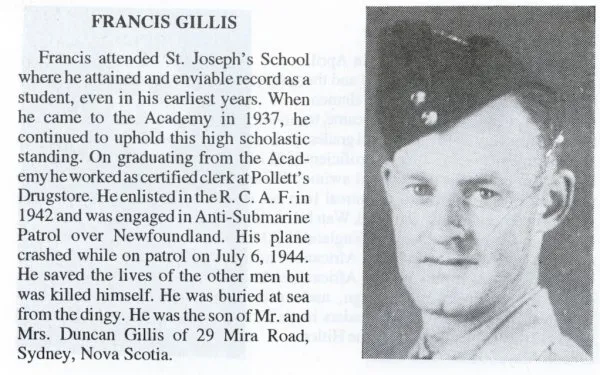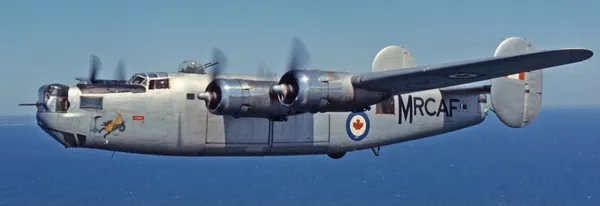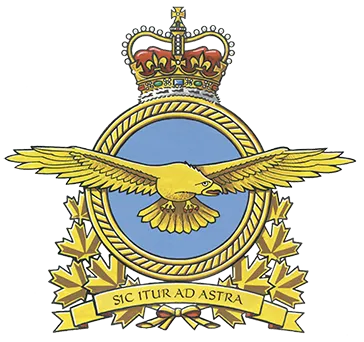Gillis, Francis Duncan (Flying Officer)
Killed in Action 1945-July-06


Birth Date: 1917-February-25
Born:
Parents: Son of Duncan A. Gillis and Loretta Gillis, of Sydney, Nova Scotia.
Spouse:
Home: Sydney, Nova Scotia
Enlistment:
Enlistment Date: unkown date
Service
RCAF
Unit
10 (BR) Sqn- Squadron
Base
Rank
Flying Officer
Position
Pilot
Service Numbers
J/26797
Home
Crew or Other Personnel
Liberator 595
Liberator serial: 595

Consolidated Liberator G.R. Mk. VIII, RCAF (Serial No. 11130) ex-USAAF Consolidated (Vultee) B-24L Liberator USAAF (44-50154)
ex-RAF (Serial No. 5009), ex-Indian Air Force (Serial No. HE773).
Currently preserved in the Canada Aviation and Space Museum Ottawa Ontario.
The Consolidated B-24 Liberator was an American heavy bomber flown by the RCAF during the Second Word War. It was designed with a shoulder-mounted, high aspect ratio Davis wing which gave the Liberator a high cruise speed, long range and the ability to carry a heavy bomb load. Early RAF Liberators were the first aircraft to cross the Atlantic Ocean as a matter of routine. In comparison with its contemporaries the B-24 was relatively difficult to fly and had poor low speed performance; it also had a lower ceiling compared with the Boeing B-17 Flying Fortress. Of the roughly 18,500 B-24s built in the USA during the war, 148 were flown by the RCAF on long range anti-submarine patrols, with the B-24 serving an instrumental role in closing the Mid-Atlantic gap in the Battle of the Atlantic. The RCAF also flew a few B-24s post war as transports.
Roughly half of all (RAF) Liberator crews in the China-Burma-India (CBI) Theatre were Canadian by the end of the war. John Muir of Vancouver flew the longest mission of the war: 24hrs, 10mins from Ceylon to Burma and back. (Kyle Hood) Harold Skaarup web page
Aircraft Images
Liberator 595
Liberator Mk. III/V 595
Ex USAAF B-24D-60-CO s/n 42-40469, ex RAF BZ735. Also known as G.R. Mk. V/Can. Operated by No. 10 (BR) Squadron, RCAF Station Gander, Newfoundland, from May 1943. Coded "X". Attacked and damaged 2 submarines on 22 September 1943, U-377 and U-402. The second boat was attacked with guns only, as all depth charges and both homing torpedos had been used to damage U-377 a few minutes earlier.1943-04-30 Taken on Strength 2019-08-20
1944-February-19 Accident: 10 Squadron Loc: Aerodrome Names: Dicksos | Guibord | Hollinger | Luscombe | Walter | Wilson
1945-July-06 Accident: 10 Squadron Loc: 51:47n 47:40w Names: Armstrong | Bates | Gillis | Lundy | Mcarthur | Mcnab | Southam
1945-07-23 Struck off Strength Lost at sea off coast of Newfoundland, while searching for downed pilot. One fatality. 1945-078-06 Struck off on 23 July 1945. 2020-09-23
Unit Desciption
10 (BR) Sqn ()
Battle honours
The Second World War
NORTH-WEST ATLANTIC, 1940-1945.

Lineage
Authorized as ‘No.10 (Torpedo Bomber) Squadron’ 1 April 1938.Footnote1
Redesignated 'No.10 (Bomber) Squadron' 28 August 1939.Footnote2
Redesignated 'No.10 (Bomber Reconnaissance) Squadron' 1 September 1939.Footnote3
Disbanded 13 August 1945.Footnote4
Notes:
No lineal connection with '10 Experimental Squadron', of 1967-70. See 10 Experimental Squadron.
Operational history
The Second World War
The squadron flew on anti-submarine operations on the Atlantic Coast under 'Eastern Air Command'.Footnote5
Footnotes
Footnote 1
GO 48/38. Authorized but not formed (AFGO 19/39)
Footnote 2
AFGO 41/39
Footnote 3
AFGO 57/39\
Footnote 4
Secret Organization Order 279, 4 August 1945, file S.17-10-1 (DOE), Kardex 181.009 (D5432)
Footnote 5
AFGO 25/40; Statement and Organization Charts for the Home and Overseas War and BCATP Organization, 15 April 1942, file S.8202, Kardex 181.002 (D421); Memorandum, Notes for CAS, Appendix A, 12 September 1939, Document Collection 77/543
Government of Canada